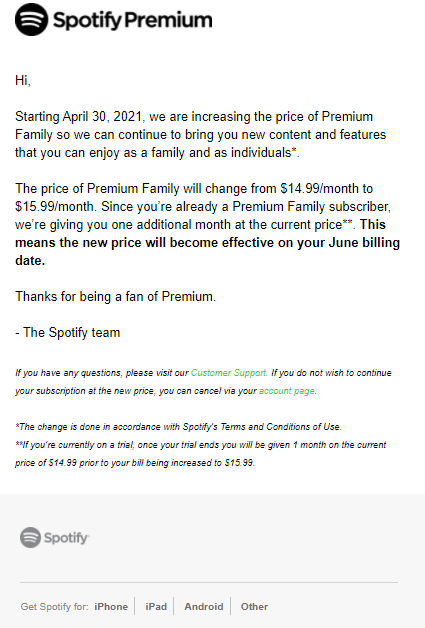Rate increases are officially trending in senior living.
McKnight’s and the Wall Street Journal covered rising rates in September, and Senior Housing News just published a piece about next year’s likely hikes. And we’re dedicating this month’s blog post to the topic as well.
Specifically, we were interested in how operators might communicate rate hikes to residents and prospective residents to soften the blow.
It’s a significant question: senior living may be reaching an inflection point of sorts. We’re hearing that banks are looking at the possibility of forcing community sales in the next three to six months, and there’s a growing concern among experts that another macroeconomic shock – a so-called “washout event” similar in scale to the pandemic or the fighting in Ukraine – may hit in the next quarter or so.
All of this to say: rate hikes won’t be negotiable for many communities in 2023. Here, we’ll explore some strategies for communicating those increases effectively.
What to Expect: Double-Digit Rate Increases
Many communities delayed rate hikes for the last two years to stanch Covid-related turnover and move-in hesitancy. Meanwhile, costs keep rising. Regardless of current occupancy, further delays in rate increases just aren’t on the table for a lot of the industry.
So what might hikes look like? We’re hearing that up to the 15 percent range won’t be uncommon.
That’s admittedly bigger than what many residents are used to, but potentially still below what communities need to charge to keep up with rising expenses. (For context, multifamily rents this spring jumped an average of nearly 20 percent YoY.)
As always, though, what’s normal varies by market. If you’re curious about what your competing communities are doing, let us know: we can pull their rate data for you.
Now let’s get into some strategies for breaking the news to residents and communicating new rates to prospects.
Communicating the Rate Increases
There’s an art to telling people you’re about to start charging them more for the same thing. The way you break the news can have a big impact on how people take it. Netflix botched its rate increase at the start of the year, hiking costs after removing hundreds of popular TV shows and movies and losing nearly a million subscribers.
Admittedly, it’s harder to leave a senior living community than a streaming service, but looking to other industries can provide inspiration for crafting communications around upcoming rate hikes. Here are some strategies worth considering.
1. Lead with value
People don’t choose housing based (solely) on price. Lean into that reality when communicating rate increases: the staff residents love and depend on have higher rent and grocery costs. To keep those staff members, the community has to pay them more.
Plus, residents watch the news; they’re aware of inflation. Position rate increases as a necessary step in a changing economy to continue providing the care and community they rely on.
We recently came across a masterful example of this kind of messaging in an email about subscription service price increases from sustainable diaper brand DYPER (see Figure 1).

Figure 1: A value-driven message announcing a price increase
Why is this communication so successful? Because, in a letter announcing a price increase, the founder manages to make money the least important thing. The main focus is the value DYPER brings to its customers and the ways its mission aligns with customers’ beliefs. When there’s an exceptional product that connects to your values, what’s an extra $15 (or 15 percent) per month?
2. Repeat, repeat, repeat
What’s worse than a significant price increase? Being taken off guard by a significant price increase.
Saying as little as possible may seem like a good way to minimize the impact of a rate increase, but that strategy rarely works. People need to hear a message about seven times before it sinks in. So a single notice 30 days before a rate takes effect will probably lead to a lot of angry phone calls when the new bills go out.
For maximum effectiveness, repetition should also involve multiple formats. For example:
- A letter (similar to the example above) to every resident and involved family member 90 days before the increase hits.
- A recurring pop-up on your resident portal.
- Phone calls from administrative staff to follow up with residents or designated family members.
And so on.
3. Use customer psychology to your benefit
It may seem like a small thing, but the effect of the $0.99 principle is real: set new prices just under a large amount, and they’ll go down a bit easier. Because we read left to right, our brains put $5,999 in the $5,000 – $5,999 bracket, not the $6,000 – $6,999 bracket.
4. Split the increase in two
It’s harder to message an increase of 15 percent than an increase of, say, eight percent Jan. 1 and another 10 percent in April. However you split the increase, though, communication is key to preventing unpleasant surprise among residents.
5. Rethink incentives
All the value messaging in the world won’t change the fact that your prices are going up. And while nobody wants to lead with concessions, for example, having a few incentives for your sales team to pull out can be a powerful tool in an era of rate increases.
And not all incentives have to be hugely expensive. For example, we found the strategy in a recent Spotify price hike interesting (see Figure 2): the company announced a price hike and its effective date, then extended the current price an extra month.
The move is pure messaging, of course, but it still feels like a little win.

Figure 2: Spotify’s price increase email
Looking beyond Rates for Revenue Growth
Even the best communications strategy can only go so far to soften the blow of increased rates. In some cases, communities won’t be able to raise rates as much as they’d like to maintain margins. In those cases, it may be time to look beyond rate increases to grow revenue – e.g., by opening access to community amenities to non-residents or expanding into ancillary services.
Whatever your plan for 2023, we’d love to be a part of it. Get in touch, and we can put together an analysis of current rates in your market.



